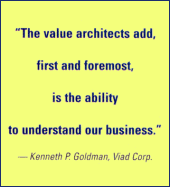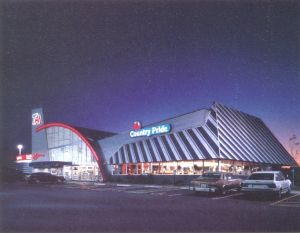
A |
stute architects today bring more to the table than a set of drawings. Corporate and industrial real estate owners are asking — and more often than not expecting — design professionals to add value to the project team, new value measured in terms of staffing and strategy, savings and speed.
Integrated delivery systems, preferred vendor relationships, and compressed time packages are replacing the “a la carte” service approaches previously purchased by corporate real estate managers. Traditional design/bid/build delivery and standard packages of services are anachronistic. The need to save time has become a more important factor than low-tech bricks and mortar in project delivery. Architects add value when they serve as strategic allies, provide expert knowledge, organize facility delivery, merge design and construction processes and compress time by stepping outside of traditional roles.
Raymond G. DuPont, vice president and regional head of Citibank’s Corporate Realty Services in Europe, the Middle East and Africa, has witnessed the changing and expanding roles of architects in ventures in the United States and abroad. “Historically, companies employed their own staff of technically competent people,” he relates. “With large volumes of construction and the need for consistency and standards, it made sense to put the design together in-house and to use the traditional master-build processes.”

But as companies have become cost conscious and more comfortable using design-build techniques, and have begun to be more global in their outlook, there is no longer a need to carry an extensive in-house staff of experts, he argues. “By having an architect responsible for project management and delivery as well as design, corporate real estate can avoid cost redundancies, or problems associated with coordination of construction and architectural conflicts. Instead, real estate groups can put together a scope specification and turn to an architect team to get the job done. This not only reduces costs, but is a faster, more efficient design construction process.”
The Architect as Business Partner
With design-build, development risk can be transferred from the owner to a single source responsible for the entire project. As ally, the architect must be aware of the strategic business goals of the corporate real estate team.

“The value architects add, first and foremost, is the ability to understand our business,” points out Kenneth P. Goldman, corporate real estate director at Viad Corp., Phoenix. “Without that, they are unable to provide the best layout or engineer the best systems for our needs. Architects need to grasp fairly quickly what we do, how we do it and why we do it. They need to ask the right questions and listen to the answers. Only then can they become part of our team.”
Architects need to know when to keep things simple and when to hold clients’ hands, Goldman stresses. “They need to know how to bring us together and build consensus, to synthesize our ideas and come back with a plan everyone feels they have input on, something everyone believes will work.”
truckstops in such a way that schedules were met and revenues increased dramatically.
As strategic partner, the architect is in an ideal position to represent the corporate real estate owner as intermediary in the public approval process with government agencies and to articulate goals in a way that is credible to the public and key stakeholders.
Involved early on in this new tactical role, the architect also protects future options for the owner and creates flexibility, not only in terms of building structure, but in terms of the ability to expand, contract or exit.
Adds Goldman, “Flexibility is key, and not just in physical terms. As we enter into leases to maximize the efficiency of our operations, we weigh options for design and build out with an eye to an exit strategy. Change is constant, and the more an architect can integrate flexibility into the plan, the more likely we will avoid incurring future dead rent costs. We wrestle with costs on every project,” he notes. “A lot is tied up with decisions as to hard walls versus open space and modular units. If an architect can come up with creative solutions that favorably impact costs yet retain flexibility, we will listen.”
Filling in the Gaps
Shrinking budgets, “rightsizing” and consolidation are forcing corporate real estate groups to build more with less. Established providers and preferred-vendor programs are filling the owner’s gaps for the necessary resources and expertise.
“A new model has replaced traditional owner-architect-contractor relationships,” says Jack M. Logue, associate division director at Argonne National Laboratory, Argonne, Ill. “By necessity, corporate real estate owners have divested themselves of staff that formerly developed scope and program requirements for a project. Yet the same work needs to get done. Architects are increasingly taking up the slack,” he points out. “They are now entering the project stream early on, assembling information and producing a program — in addition to executing a design.”
Relationship building occurs naturally when an owner does not have overhead staff and yet needs to get job done quickly, says Logue. “It is easier to turn to established people who understand your requirements, can put the right information together and help you decide what you need to do. An owner will go to where the expertise is,” he says.
Viad’s Goldman agrees. “Rapport and communication with an architect is important to us. If we have a single point of contact with a base architectural team upon whom we can count, then we have an efficient and effective team. We want to make sure the learning curve is done once, and move on by drawing upon that experience and the information they have about us.”
Project team members that can compress time and produce substantial savings through their delivery approach make an impact where it counts, because time has become the single greatest factor in project development. Logue, for instance, continually faces accelerating timing demands. “Corporations and industries are willing to commit extra resources to become operational and producing [goods] faster,” he says. “For some industries, fast track is nothing new. But for all industries, it is the way to go.”
And there is little room for mistakes. “Owners rely on an architect who can provide accurate budgets and who has the talent to point out the viable options — the talent to summarize a plan, quantify the value decisions that inevitably arise along the way, and then coordinate and deliver the end result.”
Added Value in a Global Reach
Integrated delivery approaches also enable architects to tailor staffing resources to complement owners’ in-house organizational structures. They allow the architect to preserve confidentiality and tactically control the flow of information. The integrated matrix also responds to the increasing globalization and automation of business practices.
Ray DuPont of Citibank cites as an example the challenge of maximizing the number of employees in an office environment overseas. “We were trying to achieve greater population density and were being told we could not do it because of the intricacies of the local organization,” he recalls. “I needed the services of an outside, objective expert to convince local management and the employee work council that it was possible.”
Which is the role our firm had in conjunction with a local European firm familiar with codes and regulatory laws and the ability to assess the space. The result was a reduction in gross square feet per person from 150 sq. ft. (14 sq. m.) per person to 85-90 sq. ft. (7.8 to 8.3 sq. m.), exceeding the goal of 100 gross sq. ft. (9.3 gross sq. m.).
In this case, much of the value of our role in the project was our strategy of controlling the effort from our Cleveland office and taking advantage of the time difference to get plans to Europe for review. Solutions to the previous days’ issues could be worked on in time for them to be communicated to European counterparts by the next morning.
DuPont embraces the use of technology on the part of the architect and sees current and next generation projects being implemented through Web enablers and transfers. “If I have a single provider who is very close to our company in terms of understanding us and working with us, then that provider can serve our needs on a global basis. I can call upon that architect and get the response I need — anywhere in the world,” DuPont reasons.
Even Truckstops Need New Thinking
Integrated delivery, market research, compressed time, and innovative thinking enabled TravelCenters of America (TA) to implement a facilities program of sites across the country, involving a new prototype travel center and re-imaging of existing truckstops — a $250 million capital expenditure over three years. Our firm created a team process to drive the project forward.
TA used market analysis to develop a vision and performance criteria for expanding their existing professional driver market and capturing enough motorist business to become the largest full-service travel center network in the nation. The architectural team incorporated market research findings into the development of the prototype program, and then tested and measured the prototype design by stringent financial and customer satisfaction targets.
The aggressive schedule for the re-imaging called for due diligence to be completed in 13 weeks, design and permits in another 12 weeks and construction in 20 weeks. This timeline was then compressed by 20 weeks. Four test cases were built to verify design and pro forma assumptions. The first four re-imaging projects resulted in a doubling of revenue in each profit center — full service restaurants, fast food restaurants, convenience stores and truck repair maintenance facilities — with even greater profit increase.
The architects dedicated an autonomous project team and placed coordinators in the owner’s office. The design team limited points of communication in order to manage information, developed written procedures for approvals and insisted on total control by one entity on the client team regarding program and financial issues and to balance needs among competing profit centers.
The firm created incentives to meet TA’s goals and incentives for the team as it works on 85 buildings for the duration of the three- year program. The team set up project-specific communication links, including group voice mail and Web sites, traded MIS personnel and integrated technology with the owner and all relevant parties.
The architects also developed prototype templates and standards for bundled procurement and rapid application. Project-specific detail libraries and customized software and icons were created to reduce time, which is critical for projects with a 1.6 month investment payback. Architectural fees were offset by revenue from a one-month acceleration of project delivery.
The success of the program quickly became. Within the first few months of operation of the upgraded facilities, revenues exceeded budgets. The design has allowed the company to capture new business, including local residents and leisure travelers, and take the lead in its existing market.

“During the design phase, the architects encouraged us to look at travel center architecture in a new way — what possibilities were available to us instead of what had been done before?” says TA’s Michael O’Connor, director of advertising and public relations. “We started with a clean sheet of paper with no preconceived ideas about what had to be done. Along the way, we were always aware of our program objectives and targeted customer mix. Because the architect is a full-service design firm, TravelCenters of America was able to select from a wide array of services including building design, permitting, structural engineering, interior design, and model making.”
business development at van Dijk Pace Westlake Architects in Phoenix and Cleveland,
a planning and design firm with specialties in corporate and workplace design and
knowledge-based markets. The firm’s Web site is www.vpwa.com.
Giving corporate and industrial real estate a competitive edge and using facilities as a strategic, business asset demonstrate architect-added value. Architects who bring knowledge-based experience, speed, and flexibility will be the ones on the teams — or leading the teams – managing new projects in the future.
“Architects who provide good design, and bring the project in ahead of schedule and under budget, help owners get their job done,” says Goldman of Viad Corp. “When a project goes smoothly, the whole team gets the kudos.”

